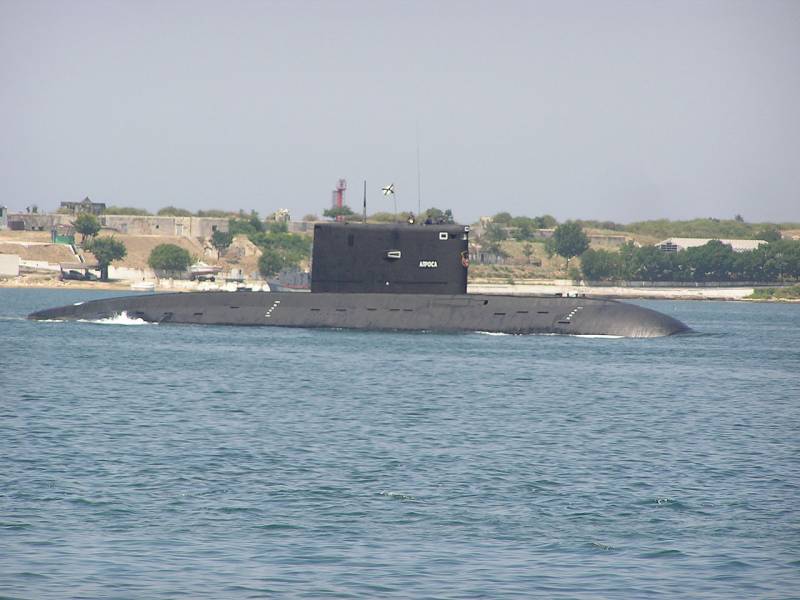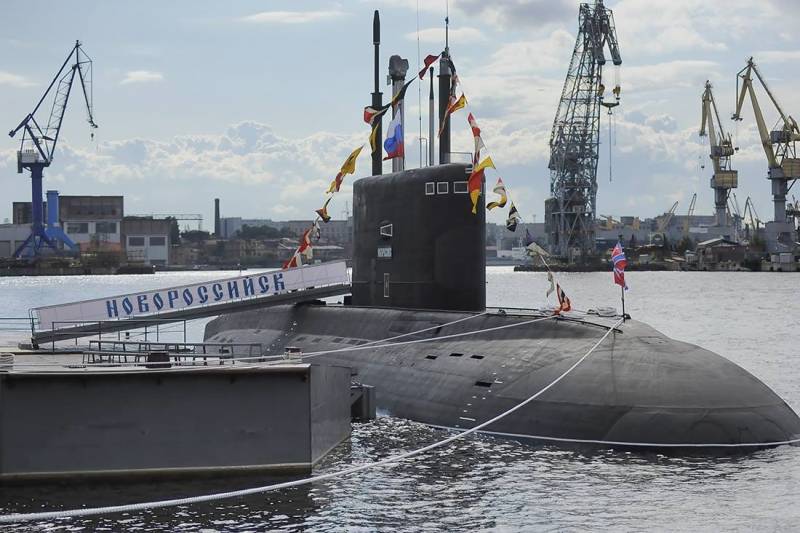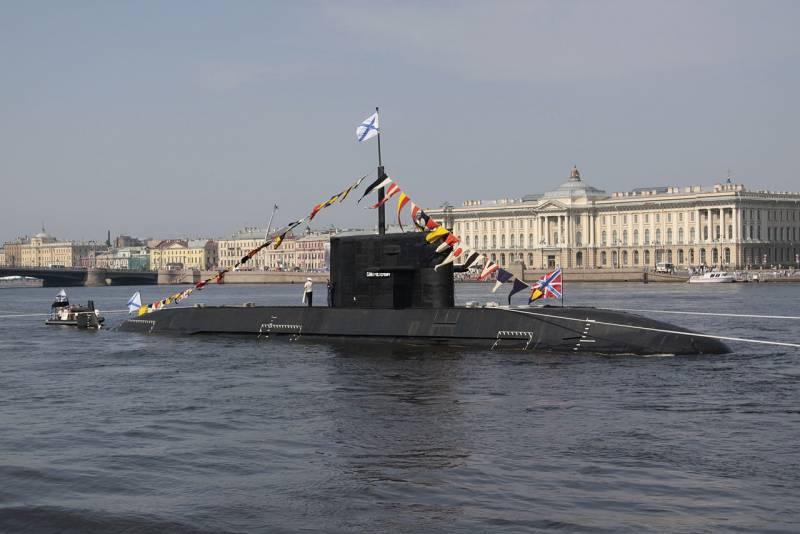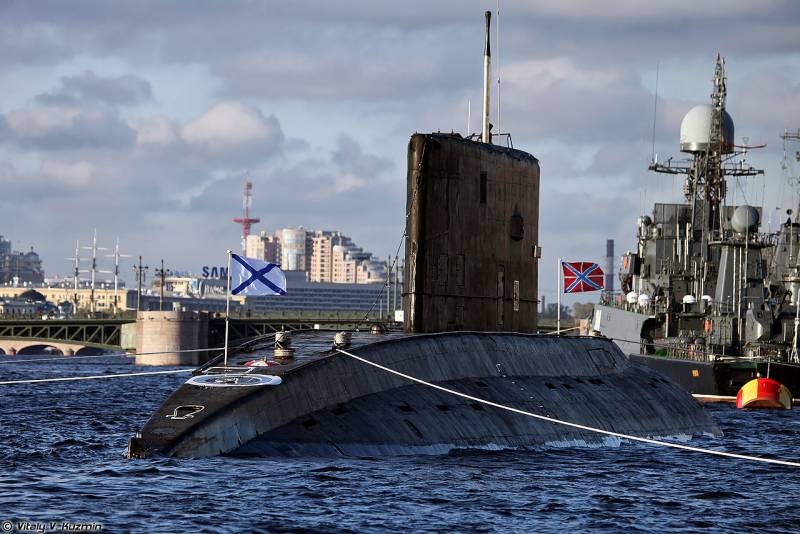"Halibut", "Varshavyanka" and "Lada". Diesel-electric submarines of the Russian fleet
During the last decades, several types of diesel-electric submarines with different characteristics and capabilities were created for the Soviet and Russian Navy. In this case, to date, the composition of the submarine grouping significantly simplified. Currently, the Russian fleet operates several types of diesel-electric boats, all relating to two projects - 877 “Halibut” and 636.3 “Varshavyanka”. “Halibut” is still the most numerous in its class, but Varshavyanka has a future.
History "Paltusov"
The construction of the diesel-electric submarines of the 877 project started at the very beginning of the eighties. From 1980 to 1991, a submarine of the “Halibus” project was built and transferred to the 21 fleet by the forces of several Soviet enterprises. In the mid-eighties, the Soviet Navy received the only submarine of the 877EKM project - the B-806 "Dmitrov". At the end of the same decade, 877LPMB and 877В projects were built in the same boat for the domestic customer - now they are named B-800 "Kaluga" and B-871 "Alrosa".
In the mid-eighties, the construction of "Paltus" for foreign customers started. From 1985 to 2000, 19 built new ships for 877E and 877EKM projects for foreign countries. The greatest interest in the Soviet / Russian diesel-electric submarines was shown by India, which bought eight submarines. Submarines were also delivered to Algeria, Iran, China and other countries.
The resource of equipment is not infinite, and therefore from a certain time began the gradual write-off and recycling of existing diesel-electric submarines of the type “Halibus”. In the first half of the last decade, the Russian Navy was forced to abandon a significant part of its diesel-electric submarines. Before 2007, seven ships were excluded from the fleet. Soon they had to go to the break. Currently, the disposal of two more ships. Other submarines continue to serve as part of several major fleets.
Thus, for two decades, a total of 43 diesel-electric submarines “Halibus” were built and transferred to customers. 10 ships were disposed of or disabled as a result of accidents. 33 boats continue to serve, of which 15 belong to Russia. Most of these submarines now serves, and several are under repair.
"Varshavyanka" to replace
Already in the mid-nineties, Russian shipbuilders began building diesel-electric submarines of the new 636 Varshavyanka project. Initially, this project was considered as an export version of “Halibus”, but later it was decided to develop the entire field of diesel-electric submarines with his help. As a result, “Varshavyanka” of different versions were not only exported, but also transferred to their fleet.
For a long time, the 636 project boats were built only for foreign countries. In 1997 and 1998, the Chinese Navy received the first two ships of this type. From 2004 onwards, the Chinese fleet began to master the submarines of the 636M project. In just a few years, eight such boats were handed to him. Also on the project with the letter "M" built a pair of submarines for Algeria. In 2010-17, six Warsaw-Wyang versions of 636.1 for Vietnam were being built. Total exported went 18 TEPL family 636.
In August 2010 of the year, the first submarine of the Varshavyanka family was laid for the Russian Navy. In accordance with the existing contract, the construction of six ships of the improved 636.3 project in the amount of six units was required. All new submarines were intended for the Black Sea Fleet. The order was completed by the end of 2016. In 2017, the construction of a new series of six boats started - this time for the Pacific Fleet.

Boat B-871 "Alrosa" - until recently, the only diesel-electric submarines of the Black Sea Fleet. Photo of Wikimedia Commons
In total, the 24 submarines of the Varshavyanka family have already been built. Two more ships are under construction. The diesel submarines of 636 projects are not very old and they serve without any problems. For this reason, all built ships still remain in service.
Ambiguous "Lada"
In the recent past, the further development of the non-nuclear submarine fleet was associated with the 677 Lada project. It was assumed that the “Lada” will be easier and cheaper than the existing “Halibut” with similar characteristics. Indicated the possibility of building a series of two dozen ships. The construction of the head boat of the St. Petersburg B-585 project began in 1997, and in 2004 she went to sea for testing.
During the tests, serious deficiencies in the power plant were identified, which did not allow the new boat to fully operate. The next few years were spent on fine-tuning the structure, and therefore the fate of the entire project was in doubt. In particular, due to problems with the head boat for several years, the construction of the first production line was suspended.
However, all the main flaws of the Lada were corrected, which made it possible to draw up new plans. In the 2016-17, it was reported that the first two production boats of the 677 project will be completed taking into account the modifications of the lead ship. In addition, there is already a contract for the next two submarines. In 2025, there will be at least five such ships in the Navy. In the meantime, only the head submarine, which is in trial operation, has been officially handed over to the fleet.
In the fleets
One of the largest groups of diesel-electric submarines is available in the Pacific Fleet. He currently has seven halibut ships. Six ships are listed in the ranks, another one is in reserve. It should be noted that all Pacific diesel-electric submarines were built on the original 877 project and are quite old. They all went into operation from 1988 to 1994 years. In this case, repairs and upgrades were carried out repeatedly.
The submarine B-445 "St. Nicholas the Wonderworker" was put into reserve. B-187 "Komsomolsk-on-Amur", B-190 "Krasnokamensk", Yu-345 "Mogocha", B-394 "Nurlat", B-464 "Ust-Kamchatsk" and B-494 "Ust- Bolsheretsk. These ships are based in Vladivostok, but the possibility of their transfer to new ports is not excluded. In view of the great age and development of the resource, some Pacific Fleet diesel-electric submarines may be written off over the next few years. They will be replaced by new ships of the 636.3 project, the construction of which has already begun. There is an order for six such submarines.

Submarine B-261 "Novorossiysk" project 636.3 "Varshavyanka". Photo of the Ministry of Defense of the Russian Federation / mil.ru
The submarine forces of the Northern Fleet mainly consist of ships with nuclear power plants, but they also have diesel-electric boats. In total, there are six ships of this class in the Northern Fleet. At the same time, the submarine B-808 "Yaroslavl" of the project is under repair, and the only "Lada" (B-585 "St. Petersburg") continues the trial operation. B-177 "Lipetsk", "B-459" Vladikavkaz ", B-471" Magnitogorsk "and B-800" Kaluga "remain in the ranks. The latter refers to the project 877LPMB, while the others were built on the basic version of “Halibus”.
According to known data, the Northern Fleet diesel-electric submarines will continue to serve, from time to time undergoing the necessary repairs and upgrades. Replacement of these ships is not planned yet. The renewal of the submarine forces of the Northern Fleet in the coming years will be associated with the construction of new nuclear submarines.
Until 2014, the Black Sea Fleet only had one submarine, the B-871 "Alrosa" of the 877 project. In the same year they put it in for repair, which is still ongoing. According to some reports, after the completion of repair work, the boat will be transferred to the Baltic Fleet. As a result, the Black Sea Fleet will remain without its only “Halibus”. However, such events will not adversely affect the combat capability of the fleet. In 2014-16, Black Sea sailors received six new Varshavyanok versions of 636.3. The B-261 Novorossiysk B-237 Rostov-on-Don B-262 Old Oskol B-265 Krasnodar B-268 Veliky Novgorod B-271 diesel-electric submarines were built and put into operation as soon as possible. and B-XNUMX "Kolpino".
The transfer of "Alrosa" in a noticeable way will increase the combat potential of the submarine grouping of the Baltic Fleet, but even after this the number of submarines in the latter will be small. At the moment, the Baltic Fleet has only two submarines: the B-227 Vyborg (project 877) and the B-806 Dmitrov (project 877EKM). They serve with the 1983 and 1986 of the year respectively, which leads to certain restrictions. At the same time, Vyborg is currently under repair. According to some reports, this submarine is supposed to be written off over the next few years. After completion of the service, it can become a new exhibit at the Patriot Park.
Development prospects
The Russian Navy has a sufficiently large number of diesel-electric submarines. However, for well-known reasons, a significant part of such submarine forces is distinguished by a great age and therefore may need to be repaired or upgraded. Various boats regularly arrive at shipyards to restore technical readiness. In parallel, the construction of new ships.
The last diesel-electric submarines of the 877 “Halibus” project were transferred to the Russian fleet in the mid-nineties. The oldest boat of this type has been in service since 1983 of the year - already 35 years. Other ships also do not differ in small age, and besides, they are morally obsolete and require replacement. In this case there is a specific distribution of not the newest submarines between the fleets. A large fleet of such equipment is available in the Northern and Pacific Fleet. The Baltic and Black Sea in total have less “Halibut” than any of the other fleets.

Diesel submarines B-585 "St. Petersburg" - the lead ship of the project 677 "Lada". Photo of Wikimedia Commons
The need for a gradual replacement of old types of ships has already led to well-known events. In the recent past, the submarine forces of the Black Sea Fleet were strengthened with the help of a whole series of Varshavyanok. The supply of six ships increased the fleet’s combat capability, and in addition, it now allows the transfer of the older “Alrosa” to the Baltic Sea. Thus, we can expect some growth in the potential of the Baltic Fleet.
Last year, the first two submarines of the 636.3 project for the Pacific Fleet were laid. Not later than the first half of the twenties, the last of the six ordered “Varshavyanok” will go to the Pacific Ocean. One can imagine how the combat capability of the Pacific Fleet will change, with a substantial number of obsolete and modern ships at its disposal. What happens to the existing "Halibus" is unknown. It cannot be excluded that older boats will again transfer to another fleet in need of an increase in the number of submarine forces.
News recent years suggest that the submarine project 877 from the Northern Fleet will give way to diesel-electric submarines of the type "Lada". The head boat of this project has long been in trial operation, and two more are being completed. According to known data, they are designed specifically for the Northern Fleet. Later, a new submarine of the 677 project will be laid, which will probably also go to serve in the Arctic. The total number planned for the construction of the submarine project 677, however, remains unknown.
It is easy to see that the modern pace of construction of new submarines will not allow for a limited time to replace all existing submarines of the 877 project in the "one to one" ratio. However, such problems are unlikely to have serious consequences. The fact is that the new Varshavyanka have a number of serious advantages over the older Halibuses. The characteristic features of such boats will have to ensure the preservation of the overall combat capability of the fleet not at the expense of quantity, but with the help of quality.
The 636.3 project is notable for lower noise and higher driving performance, which to a certain extent affects the effectiveness of combat missions. Older “Halibuts” are armed only with torpedoes and can only attack a certain range of targets. The new project "Varshavyanka" uses a multi-purpose rocket complex "Caliber", dramatically increasing the fighting qualities of the submarine. In addition, the two types of ships differ in the composition of a variety of on-board equipment, from detection tools to weapons control systems. Thus, the lag in quantity can to a certain extent be compensated by the growth of tactical and technical characteristics.
The most important component of the Russian submarine forces are boats with non-nuclear power plants. They account for about a third of the total number of the submarine fleet, and they must solve a number of special tasks. To preserve the necessary potential of the Navy, the development and construction of modern submarines, including fundamentally new equipment and weapons, is carried out. Thus, the submarine forces will retain the required potential and the ability to perform the assigned tasks.
On the materials of the sites:
http://mil.ru/
http://tass.ru/
http://ria.ru/
http://vz.ru/
https://flot.com/
http://flotprom.ru/
http://deepstorm.ru/
http://arms-expo.ru/
https://globalsecurity.org/

Information